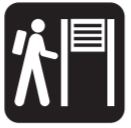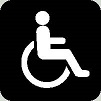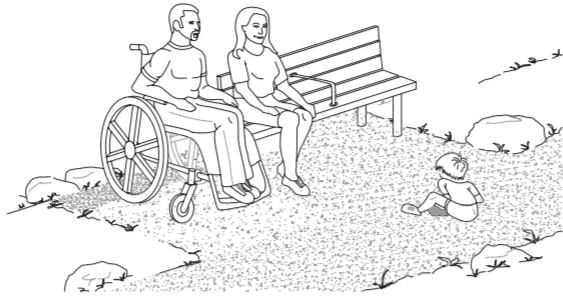Outdoor Developed Areas: A Summary of Accessibility Standards for Federal Outdoor Developed Areas
Trailheads and Trail Facilities
Definition [F106.5]

A trailhead is defined as an outdoor space that is designated by an entity responsible for administering or maintaining a trail to serve as an access point to the trail. The junction of two or more trails or the undeveloped junction of a trail and a road is not a trailhead. For example, if a trail crosses the road, the crossing does not automatically become a trailhead.
Trailhead Information Signs [F216.13 and 1017.10]

All hikers need trail information to make informed decisions. For example, hikers want to know which trail is most appropriate for the amount of time they have available, the people in their group, and the type of hike that best suits their needs or desires. Information about the accessibility of a trail enables people with disabilities to decide whether the characteristics of the trail are suited to their abilities. When this information is available on Web sites and in printed materials, it allows all hikers, including people with disabilities, the opportunity to understand the possible challenges of the trail before arriving at the trailhead.
When a new trail information sign is provided at the trailhead on a newly constructed or altered trail designed for use by hikers or pedestrians, the sign must provide information about the accessible characteristics of the trail. This requirement applies to new trailhead information signs regardless of whether the newly constructed or altered trail complies with the technical requirements for trails.
The new trail information signs must include the following information:
-
Length of the trail or trail segment
-
Type of trail surface
-
Typical and minimum trail tread width
-
Typical and maximum trail grade
-
Typical and maximum trail cross slope
Signs can provide additional information to help people with disabilities decide whether or not to attempt a trail. For example, information about the height of any major obstacles, such as boulders in the trail tread, can help people determine if they can overcome these barriers. It is helpful to have a caution notice indicating that the posted information reflects the condition of the trail when it was constructed or assessed and on what date the information was current. Because conditions in the outdoors are subject to change, knowing when an assessment was made is very helpful.

International Symbol of Accessibility (ISA)
The ISA is not required or encouraged on trail information signs.
Section F216.2 of the ABA Standards requires exterior signs that identify spaces by name to comply with the technical requirements for visual characters in section 703.5 of the ABA Standards, including the provisions for contrast of the characters and their background, and character size and style. Consequently, if a trail information sign identifies the name of the trail, the name of the trail must comply with the technical requirements for visual characters in section 703.5 of the ABA Standards. Tactile characters, Braille, and the International Symbol of Accessibility are not required on trail information signs.
Section F205 of the ABA Standards requires operable parts in accessible spaces to comply with the technical requirements for operable parts in section 309 of the ABA Standards, including the provisions for clear ground space, reach ranges, and operation. Consequently, if bins or holders for materials, such as maps, brochures, or fee envelopes, are provided at trailheads, a clear ground space at least 30 by 48 inches must be provided at the bins or holders. The bins or holders must be located a minimum of 15 inches and a maximum of 48 inches above the ground surface. If a latch or lid is provided, it must be operable using one hand without tightly grasping, pinching, or twisting the wrist.
Outdoor Constructed Features at Trailheads [F247.3.1 and 1011]
When outdoor constructed features, such as benches, picnic tables, or trash and recycling receptacles, are provided at trailheads, at least 20 percent, but no less than one, of each type of element provided must comply with the applicable technical requirements for the element. The technical requirements for outdoor constructed features are discussed in the section of this guide on outdoor constructed features.
Toilet and bathing facilities, parking facilities, and drinking fountains must comply with the applicable sections of the ABA Standards.
Outdoor Recreation Access Routes at Trailheads [F247.3.2]
Trailheads are usually accessed by vehicle rather than by hiking. At least one outdoor recreation access route (ORAR) must connect the following at trailheads:
-
Accessible parking spaces or other arrival points
-
The starting point of the trail
-
Accessible elements, spaces, and facilities within the trailhead
The technical requirements for ORARs are discussed in the section of this guide on ORARs. ORARs provide greater accessibility than a trail because areas served by ORARs are typically more developed than trails.
Existing Trailheads [F202.3]
At existing trailheads, if elements or spaces are altered but the circulation path to the altered space or element is not changed, the circulation path does not have to be altered to comply with the technical requirements of ORARs. If the circulation path at a trailhead is altered and a condition for exception does not permit full compliance with a specific provision in the technical requirements for ORARs, the circulation path must comply with the specific provision to the extent practicable. Additional information on the conditions for exceptions is provided in the section of this guide on the conditions for exceptions.
Camping and Picnic Facilities and Viewing Areas on Trails [F247.4]
When camping and picnic facilities or viewing areas are constructed or altered along a trail, they must comply with the applicable scoping and technical requirements for the facility, regardless of whether the trail complies with the technical requirements for trails. The scoping and technical requirements for camping and picnic facilities and viewing areas are discussed in the sections of this guide on camping and picnic facilities and viewing areas.
ORARs are not required to connect trails to camping and picnic facilities, viewing areas, and pit toilets along the trails. On trails that comply with the technical requirements for trails, the routes that connect the trails to camping and picnic facilities, viewing areas, and pit toilets along the trails, including accessible elements within the facilities, must comply with the technical requirements for trails. On trails that do not comply with the technical requirements for trails, there are no technical requirements for the routes that connect the trails to camping and picnic facilities, viewing areas, and pit toilets along the trails.
Where bridges are provided along trails that substantially comply with the technical requirements for trails, the bridges must also be constructed to meet the trail technical requirements.
Outdoor Constructed Features Along Trails [F247.5]
When outdoor constructed features, such as benches (figure 11), picnic tables, or trash and recycling receptacles, are provided along a trail, at least 20 percent, but no less than one, of each type of element provided at each location on the trail (other than within camping and picnic facilities and viewing areas, which have their own scoping requirements for outdoor constructed features) must comply with the applicable technical requirements for the element, regardless of whether the trail complies with the technical requirements for trails. The technical requirements for outdoor constructed features are discussed in the section of this guide on outdoor constructed features.

Figure 11—A bench is an example of an outdoor constructed feature along a trail.

User Comments/Questions
Add Comment/Question